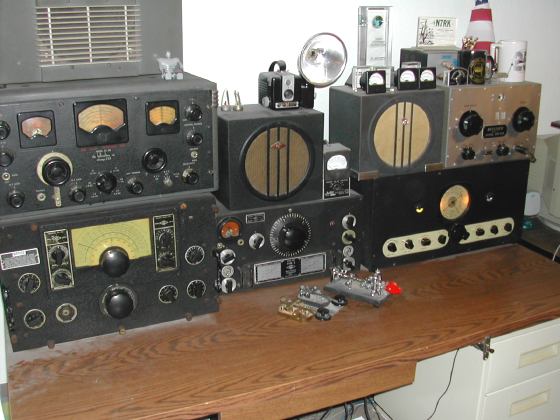![]()
|
Arvin |
|
|
|
Arvin 518 "Phantom Baby" - 1936 Five tube, two band radio covering BC and SW. This was my first old broadcast radio. I got this in 1965 by trading a homebrew VFO for it. |
|
|
Arvin Bakelite - 1940? Five tube, covering broadcast band. Model number is unknown. |
|
Delco |
|
|
|
Delco 1105 - 1935 Five tube, two band radio covering BC and SW. |
|
Hallicrafters |
|
|
|
SX-9 Super Skyrider - 1936 Nine tube superhet covering 540 kHz to 42 MHz with a crystal filter and built-in speaker. This is an early version according to the Dachis book. |
|
|
My first receiver. My dad loaned me his in 1962 and by listening to this I got interested in amateur radio. I got this on on Ebay last year as my dad would not part with his. This is a 6 tube receiver covering 540 kHz to 30 MHz. The "W" designator indicates a white cabinet. Also made was an S-41G for gray cabinet. See below |
|
Meissner |
|
|
|
Meissner - Mid 1940's Five tube, two band radio covering BC and SW. A very sensitive radio. Appears to be the same chassis used in the highly desirable Tropicana mirrored radio. |
|
Motorola |
|
|
|
Military BC-611 WWII Walkie Talkie made by Motorola. This is still seen in many WWII movies and most recently in the movie Pearl Harbor. Radio uses miniature tubes powered by a 1.5 volt battery for the filament and 105 volts for B+. This unit is on 3840 kHz. |
|
National |
|
|
|
HRO-7 - 1947-1949 12 tube, 9 band receiver with plug-in coils, separate speaker and separate power supply. Basically an HRO-5 in a new cabinet - the first post war HRO. |
|
|
NC-101X and Factory Speaker - 1936-1939 12 tube ham band only receiver covering 160, 80, 40, 20 and 10 meters. This is the later version with an S-meter. Earlier version has a tuning eye. This is a moving catacomb coil receiver and a ham band only version of the NC-100ASD which is shown below in the photo. |
|
|
NC-46 - 1945-1947 10 tube general coverage receiver covering 550 kHz to 30 MHz. Neat to look at but not the greatest performer. I also have the factory speaker although not shown. |
|
|
NC-98 and Factory Speaker - 1954-1956 9 tube general coverage receiver covering 550 kHz to 40 MHz with factory speaker |
|
Philco |
|
|
|
Philco 37-60 Cathedral Radio - 1937 Five tube, two band radio covering BC and SW. |
|
|
Philco 48-464 Bakelite -1948 Six tube, two band radio covering BC and SW. Beautiful bakelite radio; lousy picture |
|
RME |
|
|
|
RME-69/LS-1 - 1935-1940 Eleven tube, six band communications receiver covering 550 kHz - 32 MHz. This model has the noise silencer in the lower right hand corner and the factory speaker. |
|
Sonora |
|
|
|
Sonora Clock Radio - 1940's? This belonged to my Grandmother. I found it in my aunt's cellar in Chicago while visiting in November of 1999 |
|
Zenith |
|
|
|
Zenith 6D2615-N "Boomerang" Dial - 1942 Six tube, broadcast band. A very nice sounding radio. |
|
|
Zenith 4B-131 Tombstone - 1937 Four tube, broadcast band farm radio |
|
Various Smaller Radios and Canoe Anchors |
|
|
|
From left to right and top to bottom
|
More Classic Boatanchor Receivers
Starting at the top from left to right
Bottom row which is not visible in photo

I use the Meissner Signal Shifter with it's 8 watts out as my transmitter and I can switch between the following receivers: Hallicrafters SX-28 and PM-23 speaker, National RAO-7, National HRO-5T and factory speaker and RCA ACR-175 from 1936. The three keys are: a 1940's Vibroplex bug, my original E.F. Johnson straight key that I got as a novice in 1963, and a brass Signal Electric key. I have always preferred straight keys with skirts as I find them more comfortable to send with.
The HRO-5T is special to me. It belonged to my Elmer, W6BAM and I used to use it at his station back in the early 1960's when I was a kid (ages 11-14). Even though I had a top of the line Hallicrafters SX-115, I thought it was a really neat receiver. He had bought it new when he came back from WWII and used it up into the late 1980's. He sold it to me in 1995 and I brought it back to Phoenix from northern California on the airplane in my carryon! I stopped at a packing store and had them pack the coils, speaker and power supply which were than checked as baggage. I threw my expensive 3 piece suit, tie and shirt into a paper shopping bag and carried it on the plane also. Although it looks stock, he added a voltage regulator circuit to the oscillator which results in it being a much more stable and usable receiver. He also modified a couple of the plug-in coils so that I have a 15 meter bandspread coil and a 160 meter bandspread coil which was made from a broadcast band coil.
Created on 1/1/00
Photographs and text can be reproduced provided that they are credited to David S. Hollander.